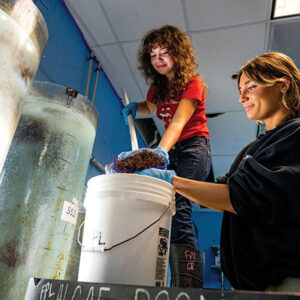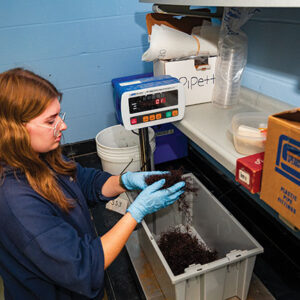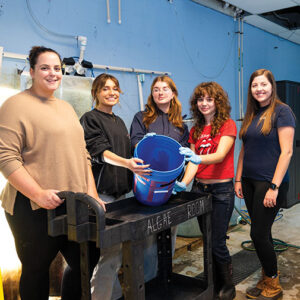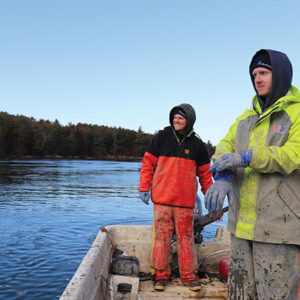
Fostering the future
April 26, 2024
By Lynn Fantom
From online games to paid apprenticeships, the aquaculture industry is creating a workforce for the future
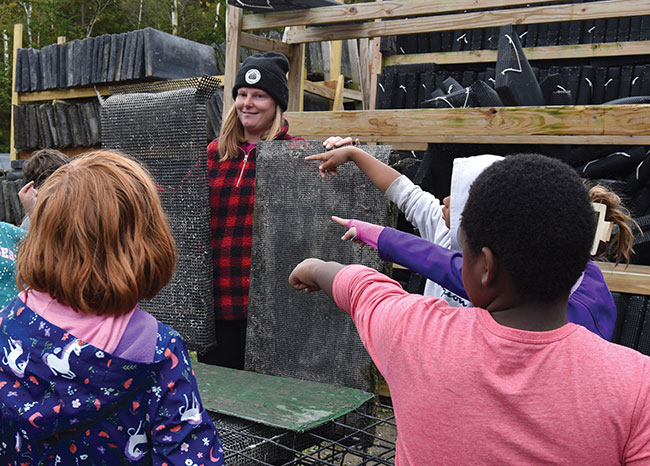 Eight classes of third and fourth graders, who were part of GMRI’s pilot program to test a new technology game, visited Mere Point Oyster Company and Bar Harbor Oyster Company.
Photo: GMRI
Eight classes of third and fourth graders, who were part of GMRI’s pilot program to test a new technology game, visited Mere Point Oyster Company and Bar Harbor Oyster Company.
Photo: GMRI What do you want to be when you grow up?
This question is on the minds of aquaculture leaders, researchers, and educators in the northeastern United States as they create promising pathways to aquaculture careers, seeding awareness early and cultivating it as kids develop. With more dollars going toward pre-college programs, there’s also a new focus to keep talent on home surf to reap a return on investment.
This surge in innovative programming comes at a time when the U.S. is rethinking its national aquaculture development. In February, the White House National Science and Technology Council announced a new plan, the first in 40 years. One of its four strategic goals is to support infrastructure and workforce development.
“Aquaculture, in our opinion, is a growing industry. It’s an important industry. It represents an adaptive response to climate change,” said Dr. Amanda Dickes of the Gulf of Maine Research Institute (GMRI). “It’s an industry in which, frankly, the U.S. is behind other nations. And so, the more that we can help students—and the adults in their lives, both parents and teachers—become aware of this industry in their backyard, well, it’s great.”
STEM in elementary
Dickes and GMRI colleagues have been piloting a new technology game for elementary students based on a virtual oyster farm.
“It is designed to build their STEM (science, technology, engineering, math) thinking and learning rather than funnel them into aquaculture,” she said. “That’s an option, but we want to keep their possible futures big and broad, and give them the foundations of learnings so that they can choose anything.”
For third and fourth graders, the new game is compelling: a harbour seal and herring gull are their guides and “learning companions.” Perch, the Portland-based firm that designed the game, made it “welcoming and something you want to engage with,” said Dickes.
The decisions it prompts might be whether to sell out the inventory of petite oysters, which have the highest unit price, or to cater to other buyers who will purchase any size, but at a lower price. Or what about the buyer who is offering a lower price, but will buy a greater quantity?
“We were really interested in teaching this age group some basic principles of economics,” Dickes continued. It’s also a way to integrate more science into the curriculum in the elementary grades when literacy and math take primacy over other subjects.
Customized lessons may be added to the curriculum but the gameplay can stand alone as a learning tool in the classroom or at home — accessible simply through a link.
During GMRI’s development process, eight classes went on farm visits to Mere Point Oyster Company and Bar Harbor Oyster Company to learn about good husbandry and see tools and machinery. For children unable to participate in such field trips, GMRI is now partnering with a team to develop a series of videos that replicate the farm visits. The game is expected to be available mid-year.
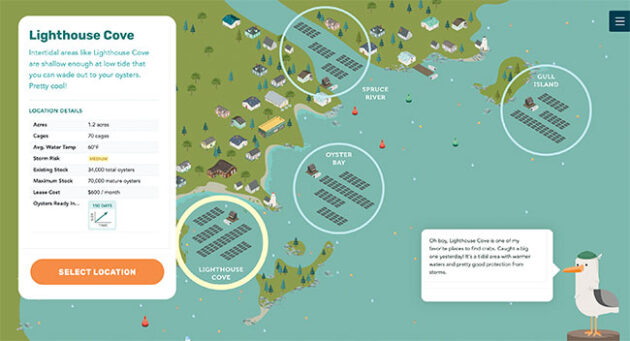
Maine elementary school students learn science and economic reasoning through a new technology game based on a virtual oyster farm. A herring gull is one of their guides. Image: GMRI
Seaweed seedlings in middle school
Also, in Maine, Boothbay Sea and Science Center (BSSC) is engaging middle and high school students in a hands-on marine science program to grow and harvest seaweed during the school year. Now in its seventh year, it has expanded from three schools in one county to 15 in seven counties, impacting over 1,000 students each year.
Starting in early fall, students cultivate seaweed seedlings for six weeks in filtered seawater in the classroom before planting them on farms on vertical drop lines in December. During the winter, they review the data they collected and develop hypotheses. The late-April harvests are accompanied by a “community presentation.”
In addition to demonstrating innovative aquaculture techniques to grow Saccharina latissimi and Alaria esculenta, the program promotes a better understanding of concepts such as sustainability and entrepreneurship, according to Pauline Dion, BSSC executive director.
Vocational high schools
In Connecticut, with the Long Island Sound at its southern boundary, three high schools have gained recognition for their hands-on marine science programs and facilities. Part of the state’s Vocational Agricultural (Vo-Ag) High School system, they accept applications from Connecticut students regardless of where they live in the state, who attend free of charge.
While students build critical thinking, problem-solving, and core proficiencies, they gain job readiness and a working knowledge of aquaculture. They explore subjects like waterfront safety, marine mechanics and vessel operation, aquaculture biology and chemistry, seafood science, genetics and biotechnology – in the classroom, lab, and water. (Yes, there are dive clubs.)
The problem is that most students who want to pursue aquaculture in college leave Connecticut for programs like those at the University of Rhode Island, University of Maine, Roger Williams University, and Auburn University. And they’re not necessarily coming back.
State-of-the-art facilities are the “big selling point for them,” according to Alysa Mullen, fish lab director and aquaculture educator at The Sound School, one of the three vo-aqua schools in Connecticut. “Our students do not want to sit in a classroom learning about aquaculture lecture style. They want to get out and do it, hands-on.”
Pathway to university
But Dr. Emma Cross, an assistant professor of coastal/marine studies at Southern Connecticut State University (SCSU), wants to retain that talent in Connecticut. Through a grant geared toward cultivating a workforce for the state’s growing aquaculture industry, she is busy developing and piloting an aquaculture curriculum that bridges high school and college.
With initial funding from NOAA, she has created two aquaculture classes that will be offered during the 2024-2025 school year at The Sound School, as well as at SCSU. The high school students will be able to earn up to eight credits at little or no cost by taking these “early college experience” classes.
“This initiative is developing an ‘aquaculture pathway’ here in Connecticut to broaden options for students so that they don’t have to go out of the state,” Cross said.
The university is covering the cost of these credits. “We believe it is a matter of social justice to provide the opportunity to take early college courses for students who have been typically underrepresented in higher education,” added Dr. Trudy Milburn, the associate vice-president for academic affairs at SCSU.
Apprenticeships on farms
Last year, the Maine Aquaculture Association (MAA) and Gulf of Maine Research Institute (GMRI) launched a paid aquaculture apprenticeship program — the first in the U.S. In partnership with Educate Maine and Southern Maine Community College, the effort was funded by the U.S. Department of Agriculture National Institute of Food and Agriculture.
Five men and one woman were selected for full-time, one-year apprenticeships at shellfish and seaweed farms across Maine. “It started with one week of aquaculture boot camp — courses (both a bit classroom and hands-on), getting people out on boats, making sure they know their knots, things like that before they even got to the farms,” said Christian Brayden of MAA.
Then the apprentices worked under the guidance of an experienced owner or employee—with hours varying by location, season, and tide. The program also included 144 hours of coursework at Southern Maine Community College.
The impetus for the program went back some seven years when Maine aquaculture companies had increasingly expressed concern about the lack of qualified workers—particularly those with some aquaculture experience to fill mid-level management roles. They needed people “who could be counted upon to run these growing businesses,” Brayden said.
One part of MAA and GMRI’s strategic response to the challenge was to create occupational standards that specified the workforce skills and experience by role, by aquaculture sector. That helped form the blueprint for the apprenticeship program.
Matt Czuchra, who grew up in Maine and studied oceanography at Canada’s Dalhousie University, apprenticed at an oyster farm in Brunswick. “I think the aquaculture industry has a lot of promise,” he said in a video produced by MAA. Since starting the apprenticeship program in April of 2023, Czuchra has gained the skills to be an oyster farm manager.
Spreading the word
Czuchra’s profile was one of the videos MAA developed to showcase the experience of the apprentices. Shot and edited by MAA’s Trixie Betz, they show what day-to-day work feels like on a farm. It can be cold and dirty but nothing beats being out on the water.
The videos also present the personal perspectives of the six apprentices. One moved to Maine from California and another came from the Alaskan fisheries. One was a recent high school graduate; others had college degrees.
“I wanted to amplify their voices because they’re the trailblazers for this program,” said Betz. She posted the videos (all under 60 seconds in length) on Instagram, Facebook, and TikTok — where they were viewed over 34,000 times. “These videos have performed better than any of the other videos we’ve posted on our pages,” she added.
Why did they resonate? Betz’s strong visual storytelling portrayed what it’s like to work outside in a beautiful place like Maine. Some apprentices talked about working alongside people they like. Others mused about the opportunity to start an independent venture in a growing industry. But the most common theme was the chance to “do the right thing” in food production and for the environment.
Advertisement
- Farm Aid encourages farmers to use mental health initiative
- Cooke Aquaculture cleans up beaches on Earth Day
